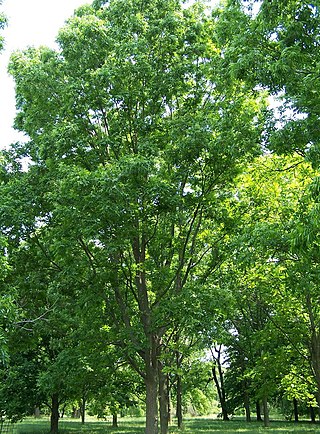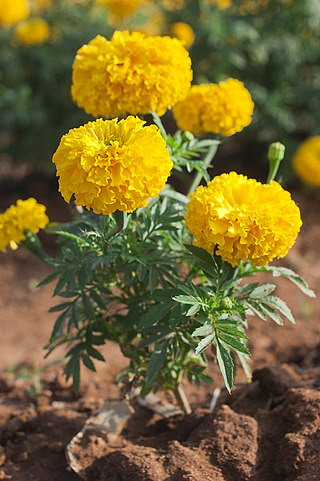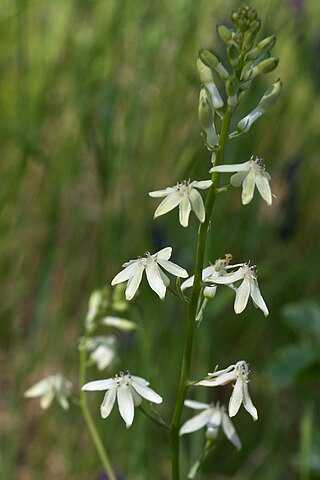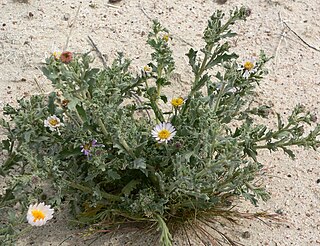
Texas A&M University is a public, land-grant, research university in College Station, Texas. It was founded in 1876 and became the flagship institution of the Texas A&M University System in 1948. Since 2021, Texas A&M has enrolled the largest student body in the United States, and is the only university in Texas to hold simultaneous designations as a land-, sea-, and space-grant institution. It is classified among "R1: Doctoral Universities – Very high research activity" and a member of the Association of American Universities.

Larrea tridentata, called creosote bush and greasewood as a plant, chaparral as a medicinal herb, and gobernadora in Mexico, due to its ability to secure more water by inhibiting the growth of nearby plants. In Sonora, it is more commonly called hediondilla; Spanish hediondo = "smelly".

The pecan is a species of hickory native to the southern United States and northern Mexico in the region of the Mississippi River.

Mesquite is a common name for several plants in the genus Prosopis, which contains over 40 species of small leguminous trees. They are native to dry areas in the Americas. They have extremely long roots to seek water from very far under ground. As a legume, mesquites are one of the few sources of fixed nitrogen in the desert habitat. The trees bloom from spring to summer. They often produce fruits known as "pods". Prosopis spp. are able to grow up to 8 metres (26 ft) tall, depending on site and climate. They are deciduous and depending on location and rainfall have either deep or shallow roots. Prosopis is considered long-lived because of the low mortality rate after the dicotyledonous stage and juveniles are also able to survive in conditions with low light and drought. The Cahuilla indigenous people of western North America were known to eat the seeds of mesquite.

Tagetes is a genus of 50 species of annual or perennial, mostly herbaceous plants in the family Asteraceae. They are among several groups of plants known in English as marigolds. The genus Tagetes was described by Carl Linnaeus in 1753.

Lantana is a genus of about 150 species of perennial flowering plants in the verbena family, Verbenaceae. They are native to tropical regions of the Americas and Africa but exist as an introduced species in numerous areas, especially in the Australian-Pacific region, South and Northeastern part of India. The genus includes both herbaceous plants and shrubs growing to 0.5–2 m (1.6–6.6 ft) tall. Their common names are shrub verbenas or lantanas. The generic name originated in Late Latin, where it refers to the unrelated Viburnum lantana.

Quercus virginiana, also known as the southern live oak, is an evergreen oak tree endemic to the Southeastern United States. Though many other species are loosely called live oak, the southern live oak is particularly iconic of the Old South. Many very large and old specimens of live oak can be found today in the Deep South region of the United States.

The jalapeño is a medium-sized chili pepper pod type cultivar of the species Capsicum annuum. A mature jalapeño chili is 5–10 cm (2–4 in) long and hangs down with a round, firm, smooth flesh of 25–38 mm wide. It can have a range of pungency, with Scoville heat units of 4,000 to 8,500. Commonly picked and consumed while still green, it is occasionally allowed to fully ripen and turn red, orange, or yellow. It is wider and generally milder than the similar Serrano pepper.

Nartheciaceae is a family of flowering plants. The APG III system places it in the order Dioscoreales, in the clade monocots. As circumscribed by APG IV (2016) it includes 35 species of herbaceous plants in the following five genera:

The Piney Woods is a temperate coniferous forest terrestrial ecoregion in the Southern United States covering 54,400 square miles (141,000 km2) of East Texas, southern Arkansas, western Louisiana, and southeastern Oklahoma. These coniferous forests are dominated by several species of pine as well as hardwoods including hickory and oak. Historically the most dense part of this forest region was the Big Thicket though the lumber industry dramatically reduced the forest concentration in this area and throughout the Piney Woods during the 19th and 20th centuries. The World Wide Fund for Nature considers the Piney Woods to be one of the critically endangered ecoregions of the United States. The United States Environmental Protection Agency (EPA) defines most of this ecoregion as the South Central Plains.

Helianthus is a genus comprising about 70 species of annual and perennial flowering plants in the daisy family Asteraceae commonly known as sunflowers. Except for three South American species, the species of Helianthus are native to North America and Central America. The best-known species is the common sunflower. This and other species, notably Jerusalem artichoke, are cultivated in temperate regions and some tropical regions, as food crops for humans, cattle, and poultry, and as ornamental plants. The species H. annuus typically grows during the summer and into early fall, with the peak growth season being mid-summer.

Monarda is a genus of flowering plants in the mint family, Lamiaceae. The genus is endemic to North America. Common names include bergamot, bee balm, horsemint, and oswego tea, the first being inspired by the fragrance of the leaves, which is reminiscent of bergamot orange. The genus was named for the Spanish botanist Nicolás Monardes, who wrote a book in 1574 describing plants of the New World.

Tecophilaeaceae is a family of flowering plants, placed in the order Asparagales of the monocots. It consists of nine genera with a total of 27 species.
A virtual power plant (VPP) is a cloud-based distributed power plant that aggregates the capacities of heterogeneous distributed energy resources (DER) for the purposes of enhancing power generation, trading or selling power on the electricity market, and demand side options for load reduction.
The John Henry Kirby State Forest is a 626-acre (2.5 km2) forest reserve located in Tyler County, Texas. Located just fourteen miles (21 km) south of Woodville and seventeen miles north of Kountze, it is used primarily for research by Texas A&M University. It is open to the public for picnics and touring only. The 6.6 mile Longleaf Nature Trail is located within the state forest. Any revenue generated is donated to student-loan programs at Texas A&M. The land was donated to the state by the lumber baron John Henry Kirby in 1929.

Arbutus xalapensis, commonly known as the Texas madrone, Amazaquitl, or Texas madroño, is a species of flowering plant in the heather family. It is native to Central America, the southwestern United States, and throughout Mexico. It is found in canyons and mountains, on rocky plains, and in oak woodlands, at altitudes of up to 3,000 m in the south of the range, but lower, down to 600 m in the north of the range.

Psilactis is a genus of North American and South American plants in the tribe Astereae within the family Asteraceae which are known by the common name tansyaster. There are six species within the genus.

On April 17, 2013, an ammonium nitrate explosion occurred at the West Fertilizer Company storage and distribution facility in West, Texas, United States, while emergency services personnel were responding to a fire at the facility. Fifteen people were killed, more than 160 were injured, and more than 150 buildings were damaged or destroyed. Investigators confirmed that ammonium nitrate was the material that exploded. On May 11, 2016, the Bureau of Alcohol, Tobacco, Firearms and Explosives stated that the fire had been deliberately set. That finding has been disputed.
Bradley Leo Buckley is a Texas veterinarian and Republican member of the Texas House of Representatives for House District 54, which includes part of Bell County and all of Lampasas County in Central Texas.

Leucosyris is a genus of flowering plants belonging to the family Asteraceae.


















